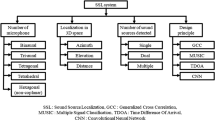Abstract
Auditory aftereffects were evaluated after short adaptation to radial sound source motion with different velocities. Approach and withdrawal of the sound source were simulated by means of rhythmical noise (from 20 Hz to 20 kHz) impulse sequences with an arising or diminishing amplitude. They were presented to an anechoic chamber through two loudspeakers placed at 1.1 and 4.5 m from the listener. The adapting stimulus velocities were 0.68, 3.43, 6.92, and 9.97 m/s with an adaptation duration of 5 s. At all motion velocities, the aftereffect manifested itself in divergence of psychometric functions upon approaching and withdrawing of adaptors. The direction of function displacements was opposite to that of the adaptor motion. Three parameters reflecting alteration of perception after motion adaptation were determined and compared with control data: the evaluation of stationary test stimuli; the velocity of moving test signal at the point of subjective equality (perceptually unmoving point); and the percentage of responses after averaging over all test signals. These parameters of auditory radial motion aftereffect similarly changed with the adaptor velocity. They demonstrated a significant effect at slow motion (0.68 and 3.43 m/s) and a small effect at a quick motion (6.92 and 9.97 m/s).
Similar content being viewed by others
References
Ehrenstein, W.H., Direction-Specific Acoustical Aftereffects, J. Acoust. Soc. Am., 1978, vol. 64, suppl. 1, p. 35.
Grantham, D.W. and Wightman, F.L., Auditory Motion Aftereffects, Percept. Psychophys., 1979, vol. 26, p. 403.
Grantham, D.W., Auditory Motion Aftereffects in the Horizontal Plane: the Effects of the Spectral Region, Spatial Sector and Spatial Richness, Acta Acustica, 1998, vol. 84, p. 337.
Neelon, M.F. and Jenison, R.L., The Effect of Trajectory on the Auditory Motion Aftereffect, Hearing Res., 2003, vol. 180, p. 57.
Neelon, M.F. and Jenison, R.L., The Temporal Growth and Decay of the Auditory Motion Aftereffect, J. Acoust. Soc. Am., 2004, vol. 115, no. 6, p. 3112.
Deas, R.W., Roach, N.W., and McGraw, P.V., Distortions of Perceived Auditory and Visual Space Following Adaptation to Motion, Exp. Brain Res., 2008, vol. 191, p. 473.
Grantham, D.W., Motion Aftereffects with Horizontally Moving Sound Sources in the Free Field, Percept. Psychophys., 1989, vol. 45, no. 2, p. 129.
Dong, C.J., Swindale, N.V., Zakarauskas, P., et al., The Auditory Motion Aftereffect: Its Tuning and Specificity in the Spatial and Frequency Domains, Percept. Psychophys., 2000, vol. 62, p. 1099.
Shu, Z.J., Swindale, N.V., and Cynader, M.S., Spectral Motion Produces an Auditory After-Effect, Nature, 1993, vol. 364, p. 721.
Andreeva, I.G. and Malinina, E.S., Auditory Motion Aftereffects of Approaching and Withdrawing Sound Sources, Fiziol. Chel., 2010, vol. 36, no. 3, p. 48 [Human Physiol. (Engl. Transl.), vol. 36, no. 3, p. 290].
Grantham, D.W., Detection and Discrimination of Simulated Motion of Auditory Targets in the Horizontal Plane, J. Acoust. Soc. Am., 1986, vol. 79, p. 1939.
Grantham, D.W, Auditory Motion Perception: Snapshots Revisited, in Binaural and Spatial Hearing in Real and Virtual Environments, Gilkey, R.H. and Anderson, T.R., Eds., Lawrence Eribaum Associates, 1997, p. 295.
Altman, J.A., Are There Neurons Detecting Direction of Sound Source Motion?, Exp. Neurol., 1968, vol. 22, p. 13.
Al’tman, Ya.A., Lokalizatsiya dvizhushchegosya istochnika zvuka (Localization of Moving Sound Sources), Leningrad: Nauka, 1983.
Warren, J.D., Zielinski, B.A., Green, G.G.R., et al., Perception of Sound-Source Motion by the Human Brain, Neuron, 2002, vol. 34, p. 139.
Altman, J.A., Syka, J., and Schmigidina, G.N., Neuronal Activity in the Medial Geniculate Body of the Cat during Monaural and Binaural Stimulation, Exp. Brain Res., 1970, vol. 10, p. 81.
Ahissar, M., Ahissar, E., Bergman, H., and Vaadia, E., Encoding of Sound Source Location and Movement: Activity of Single Neurons and Interactions between Adjacent Neurons in the Monkey Auditory Cortex, J. Neurophysiol., 1992, vol. 67, p. 203.
Jenison, R.L., Schnupp, J.W.H., Reale, R.A., and Brugge, J.F., Auditory Space-Time Receptive Field Dynamics Revealed by Spherical White-Noise Analysis, J. Neurosci., 2001, vol. 21, no. 12, p. 4408.
Altman, Ja.A. and Andreeva, I.G., Monaural and Binaural Perception of Approaching and Withdrawing Auditory Images in Human, J. Audiol., 2004, vol. 43, no. 4, p. 227.
Elliott, L.L., Backward Masking: Monotic and Dichotic Conditions, J. Acoust. Soc. Am., 1962, vol. 34, p. 1108.
Rawdon-Smith, A.F. and Gridley, G.C., An Illusion in Perception of Loudness, Brit. J. Psychol., 1935, vol. 26, p. 191.
Small, A.M., Loudness Perception of Signals of Monotonically Changing Sound Level, J. Acoust. Soc. Am., 1977, vol. 61, p. 1293.
Arlinger, S.D. and Jervall, L.B., Results of Psychoacoustic and Cortical Evoked Potential Experiments Using Frequency and Amplitude Modulated Stimuli, Scandinavian Audiol., 1979, Suppl. 9, p. 229.
Reinhardt-Rutland, A.H., Increasing- and Decreasing - Loudness Aftereffect: Asymmetrical Functions for Absolute Rate of Sound Level Change in Adapting Stimulus, J. General Psychol., 1995, vol. 122, no. 2, p. 187.
Gersuni, G.V and Vartanian, I.A, Time Dependent Features of Adequate Sound Stimuli and the Functional Organization of Central Auditory Neurons, in Basic Mechanisms in Hearing, Moller, A.R., Ed., Acad. Press, N.Y., 1973, p. 623.
Vartanyan, I.A., Slukhovoi analiz slozhnykh zvukov. Elektrofiziologicheskoe issledovanie (Auditory Analysis of Complex Sounds. Electrophysiological Study), Moscow: Nauka, 1978.
Nikitin, N.I., Auditory Analysis of Stationary and Moving Sound Signals: Electrophysiological and Psychophysiological Characteristics, Extended Abstract of Cand. Sci. (Med.) Dissertation,: St. Petersburg State University, 2009
Author information
Authors and Affiliations
Additional information
Original Russian Text © I.G. Andreeva, E.S. Malinina, 2011, published in Fiziologiya Cheloveka, 2011, Vol. 37, No. 1, pp. 75–84.
Rights and permissions
About this article
Cite this article
Andreeva, I.G., Malinina, E.S. The auditory aftereffects of radial sound source motion with different velocities. Hum Physiol 37, 66–74 (2011). https://doi.org/10.1134/S0362119711010026
Received:
Published:
Issue Date:
DOI: https://doi.org/10.1134/S0362119711010026




